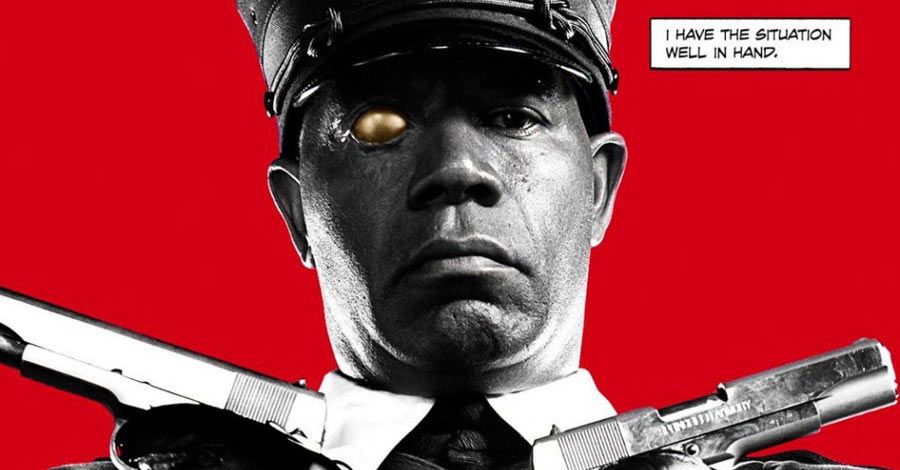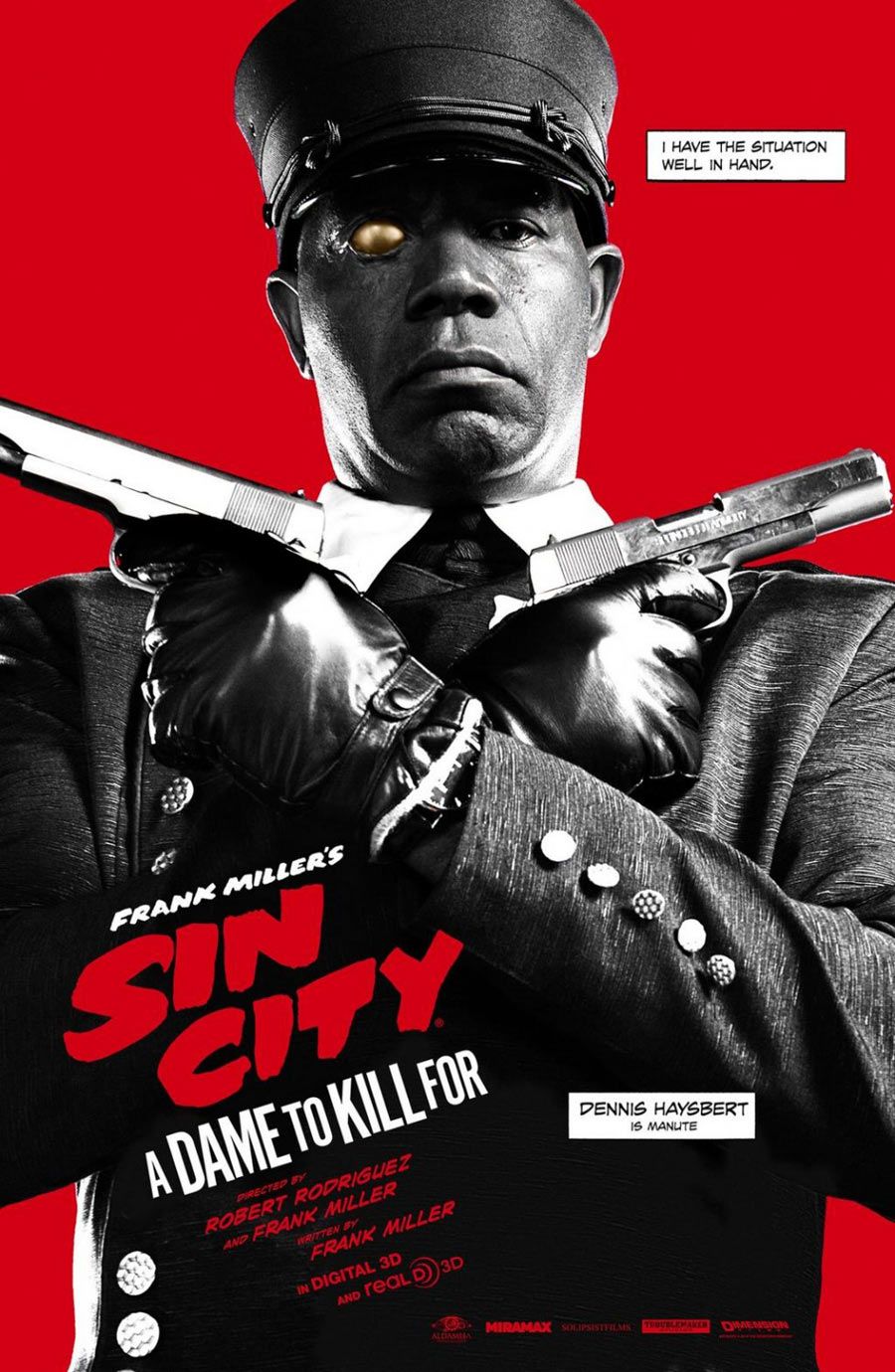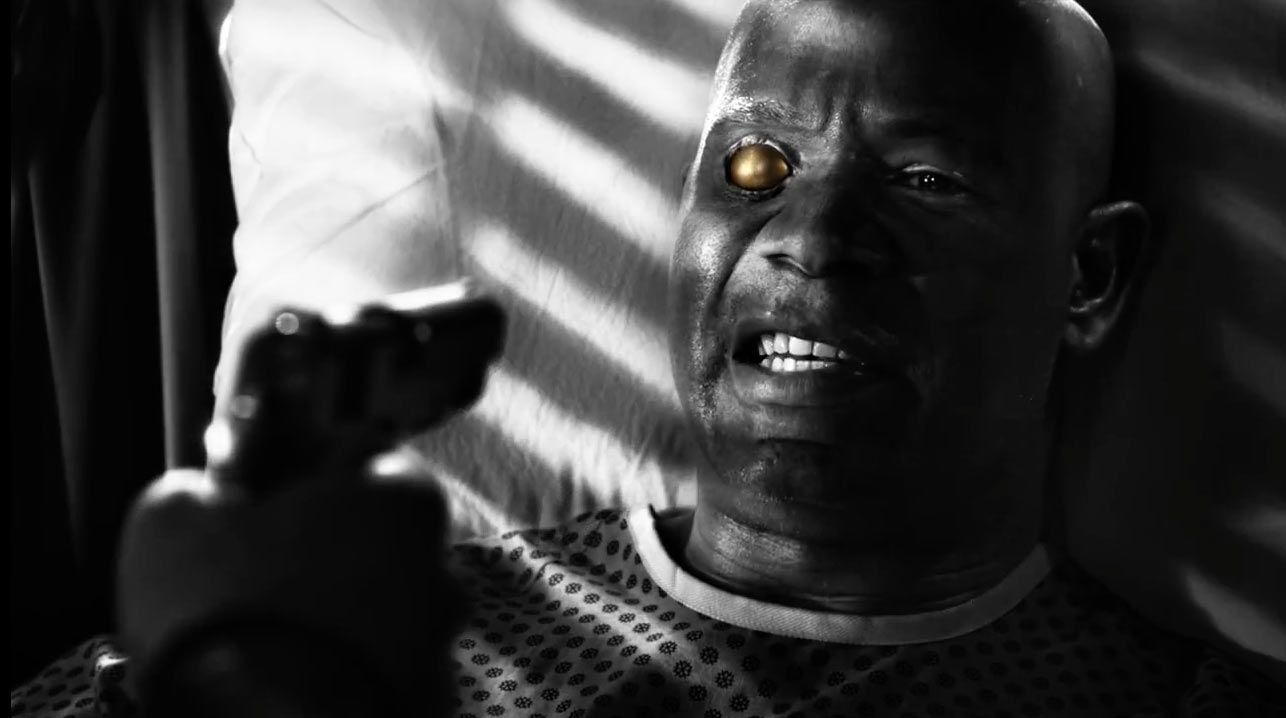It takes a pretty big man to fill the shoes of Sin City's menacing Manute, not to mention the beloved actor who first played him, but Dennis Haysbert was ready to rise to the occasion.
At 6'4" and with a distinctive basso profundo voice, the versatile and prolific film and television actor ("24," "The Unit," the "Major League" films) was made to order to embody Frank Miller's comic book creation, the hulking and decidedly deadly chauffeur/bodyguard/warden overseeing the activities of Ava Lord, the titular femme of the sequel "Sin City: A Dame to Kill For." Haysbert also wanted his performance to do right by the screen originator of the role, actor Michael Clarke Duncan, who died in 201,2 prior to the start of production on the sequel.
RELATED: Jessica Alba Inspires an Evolution For "Sin City's' Nancy Callahan
In speaking with Comic Book Resources, Haysbert revealed what it was like for him to make his first foray into the dark alleys with Miller and filmmaker Robert Rodriguez, including throwing down against Mickey Rourke's Marv, watching Eva Green in the zone and the life expectancy of any denizen of "Sin City" who isn't a good guy, an anti-hero or a bad guy.
CBR News: What was the learning curve on this movie for you, as far as the way that Robert Rodriguez and Frank Miller shoot these films? They're so heavily stylized and innovative in their use of green screen and digital manipulation -- how comfortable were you with that process going in?
Dennis Haysbert: You know, I really didn't know what to expect, but once I got on set, it's all about just doing your work. All the technical stuff really didn't come into play, except to just step in front of the camera and do your work, and all the other technical stuff just fell into place. Working on green screen is fun -- I've done that a fair bit. It just activates that creative gene in you, to use your imagination to its fullest extent. It was a lot of fun, and I love the challenge of filming this way -- and any way that I have to. I'm very flexible in that way. It doesn't matter what someone throws at me. I'm going to embrace it and just get to it.
How familiar were you with Miller's comic books? You probably were familiar with the first film, but did you know anything about Frank's books before you got involved with this project?
I didn't know anything about it until the first "Sin City" came out. I watched that and was totally engrossed and enthralled with it, and I said, "Well, let me go read these." And then to open up the books and just see these characters just pop off the pages at you -- "Man, this is going to be some franchise if they decide to go forward with it." I kind of knew they would, and I just said, "Boy, I don't know. I mean, it would be really great to be a part of it." And fortunately and unfortunately, Michael Clark left us and left this void in the "Sin City" universe, and someone had to pick it up and enter the story. I'm just glad it was me. I'm totally fascinated with the world of "Sin City" and really proud of this work.
Did you look specifically at Michael Clarke Duncan's performance to create any kind of through-lines between what he did and what you were going to do, or did you just rely on what was on the page and fill it up yourself?
Ultimately, you have to rely on what's on the page, but I always wanted to pay homage to what Michael did, so a lot of my demeanor is built on the foundation that he created. But I also had to make it my own. I think I would've heard about it from Robert and Frank if I hadn't succeeded. Now we'll see what the audience thinks.
Was there anything particularly intriguing about watching the dynamic between Robert and Frank as they made the film?
The dynamic was so seamless and flawless. They work very well in tandem, and I never got a conflicting direction, because it's so symbiotic. They both have such a handle on what it is to be in the "Sin City" universe. You can tell that they've had many, many, many, many, many conversations about how this was going to work, because when you get to set, there is no conflict. There is no straying one way or the other. You don't get schizophrenic talking to one and then the other, because they both add to it. They don't ever say the same thing, but they always enhance what you're doing in front of the camera.
Was there any sort of key facet of Manute that you picked up on that was really the secret ingredient to your performance? Something about him where you thought, "Okay, this is what I needed to know about him to make him work."
Yeah, I had a lot of conversations with Frank about who he was and how he became who he was, and where he gets his strength and his power from. And I think we decided that it was the voodoo. He's a strict practitioner of it, even though you don't see me practice voodoo in the film -- that's the resource I used to pull this character for myself. We had a lot of conversations about who he was, what he did, and the character's a lot more fleshed out in this one than I think it was in the first one. I think the Manute of the first film talked at people and talked to them, but there was no real conversation about it; in this film, there's basically this conversation, and he speaks to characters and other characters speak to him, so you get a feeling for who he is and who he's in service to. You find out very quickly that not only does he work for Eva Green's character, the Dame to Kill For, but you also know that he's in love with her. And it's an in-service kind of love, and whatever kind of love she wants to bestow upon him, he's going to take whatever she gives him. But the ultimate thing is that he's going to protect her at all costs. So this character's a lot more fleshed out, and it was just incredible working with this group of people. Josh Brolin was great to work opposite, as was Mickey Rourke and, most especially, Eva Green.
Eva Green has really been on a roll lately -- one of the most interesting actresses working right now. What was fun for you about working with her, and watching her at work?
She's just -- she's there. She's always present, a very, very sweet lady, and also a very intense lady. She kind of lived that role when she was on stage, and it was wonderful to watch her work and watch her work opposite Josh. She and he are both powers to be reckoned with, and we kind of melded. We all felt that rhythm and fell into it. It was quite a collaboration.
Tell me about that epic fight scene with Mickey, putting that together, and working with Mickey, who I know is an actor that's full of interesting curve balls.
Actually, we kind of mapped everything out. They had a great stunt crew involved in this film, and we just had an amazing time collaborating and choreographing this. We took our time -- painstakingly so -- so that nobody got hurt. It was an intense scene, but totally in balance.
Were you much of a noir fan, prior to this? Did you have any favorites in the noir genre that you'd always loved and hoped to evoke in what you were doing?
The noir of it -- I loved the old detective movies of the '40s and '50s, and I was just a big fan of film, period. I don't know if you'd call it a noir piece, but I really loved "The Third Man" and how dark and mysterious that movie was. "Dial M for Murder," "[The] Maltese Falcon." All of those movies come to mind. But you can't really compare any movie to the "Sin City" universe. It is just really unique, because it is always dark. I don't think you ever see the sun come out in anything here. It's a really dark, surreal world, and you embrace that, and you flow with it. Either you're a hero, an anti-hero or a villain. Anything else, man, you're fodder. It's a very interesting universe to be a part of.
Josh Brolin told me about how most of the time, as an actor, you're trying to get to a naturalistic state, but the "Sin City" universe, and that stylized and heightened dialogue that Frank put together, often is not naturalistic. I'm curious how you handled that as an actor -- did you find it an easy place to fit into, or did you have to think about how you were going to do it?
That's the beauty about what we, as actors, do. We take something stylized and you take it for what it is, but then, you still have to tell the truth. So you make it as naturalistic as you can, and I think that comes across, but still utilizing the stylized style of it. But still, within that style you can still tell the truth and be as natural as you can doing it. It's a challenge!



